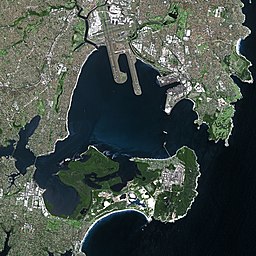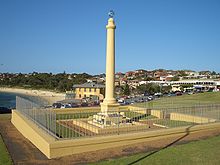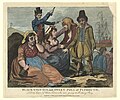Botany Bay

 Clash Royale CLAN TAG#URR8PPP
Clash Royale CLAN TAG#URR8PPP | Botany Bay | |
Sting Ray Harbour[1] | |
| an open oceanic embayment[2] | |
 Aerial photo of Sydney showing Botany Bay in the foreground | |
Name origin: great abundance of plants[1] | |
| Country | Australia |
|---|---|
| State | New South Wales |
| Region | Greater Metropolitan Sydney |
| Municipalities | Bayside, Randwick, Sutherland |
| Primary source | Georges River |
| - location | Taren Point |
| - coordinates | 34°0′33″S 151°7′44″E / 34.00917°S 151.12889°E / -34.00917; 151.12889 |
| Secondary source | Cooks River |
| - location | Kyeemagh |
| - coordinates | 33°56′57″S 151°10′6″E / 33.94917°S 151.16833°E / -33.94917; 151.16833 |
| Mouth | Tasman Sea |
| - location | Kurnell |
| - coordinates | 33°59′59″S 151°13′59″E / 33.99972°S 151.23306°E / -33.99972; 151.23306Coordinates: 33°59′59″S 151°13′59″E / 33.99972°S 151.23306°E / -33.99972; 151.23306 |
| Length | 10 km (6 mi) |
| Depth | 11.4 m (37 ft) |
| Volume | 440,815.8 m3 (15,567,263 cu ft) |
| Basin | 54.9 km2 (21 sq mi) |
| Area | 39.6 km2 (15 sq mi) |
 | |
Website: NSW Environment & Heritage webpage | |
Botany Bay, an open oceanic embayment,[2] is located in Sydney, New South Wales, Australia, 13 km (8 mi) south of the Sydney central business district. Its source is the confluence of the Georges River at Taren Point and the Cooks River at Kyeemagh, which flows 10 km (6 mi) to the east before meeting its mouth at the Tasman Sea, midpoint between La Perouse and Kurnell.
The total catchment area of the bay is approximately 55 km2 (21 sq mi). Despite its relative shallowness, the bay serves as greater metropolitan Sydney's main cargo seaport, located at Port Botany, with facilities managed by Sydney Ports Corporation. Two runways of Sydney Airport extend into the bay. Botany Bay National Park is located on the northern and southern headlands of the bay. The area surrounding the bay is generally managed by Roads and Maritime Services.
The land adjacent to Botany Bay was settled for many thousands of years by the Tharawal and Eora Aboriginal peoples and their associated clans. On 29 April 1770, Botany Bay was the site of James Cook's first landing of HMS Endeavour on the land mass of Australia, after his extensive navigation of New Zealand. Later the British planned Botany Bay as the site for a penal colony. Out of these plans came the first European habitation of Australia at Sydney Cove. Although the penal settlement was almost immediately shifted to Sydney Cove, for some time in Britain transportation to "Botany Bay" was a metonym for transportation to any of the Australian penal settlements.
Contents
1 History
1.1 Aboriginal history
1.2 British history
2 Landmarks
3 Marine life
4 In popular culture
5 Gallery
6 Notes
7 References
8 External links
History
Aboriginal history
Archaeological evidence from the shores of Botany Bay has yielded evidence of an Aboriginal settlement dating back 5,000 years. The Aboriginal people of Sydney were known as the Eora with sub-groups derived from the languages they spoke. The people living between the Cooks River and [3] while on the northern shore it was the Kameygal clan.[4] An artefact collected on Cook's first voyage in Botany Bay is the bark shield left behind by a member of a local Aboriginal tribe. This very rare object is now in the British Museum's collection and was the subject of a programme in the BBC radio series A History of the World in 100 Objects.[5]
British history

Isaac Smith became the first European to set foot on eastern Australian soil, Cook telling him "Jump out, Isaac" as the ship's boat touched the shore at Botany Bay.

Botany Bay, 1788 watercolour by Charles Gore
Lieutenant James Cook first landed at Kurnell, on the southern banks of Botany Bay, on Sunday 29 April 1770, when navigating his way up the east coast of Australia on his ship, HMS Endeavour. Cook's landing marked the beginning of Britain's interest in Australia and in the eventual colonisation of this new "southern continent".[6] Initially the name Stingrays Harbour was used by Cook and other journal keepers on his expedition, for the stingrays they caught.[7] That name was also recorded on an Admiralty chart.[8] Cook's log for 6 May 1770 records "The great quantity of these sort of fish found in this place occasioned my giving it the name of Stingrays Harbour". However, in the journal prepared later from his log, Cook wrote instead: (sic) "The great quantity of plants Mr. Banks and Dr. Solander found in this place occasioned my giving it the name of Botanist Botany Bay".[8]
Eighteen years later, in 1788, Governor Arthur Phillip sailed the armed tender HMS Supply into the bay on 18 January. Two days later the remaining ships of the First Fleet arrived to found the planned penal colony. However, the land was quickly ruled unsuitable for settlement as there was insufficient fresh water; Phillip also believed the swampy foreshores would render any colony unhealthy. Phillip decided instead to move to the excellent natural harbour of Port Jackson to the north.[9]
On the morning of 24 January the French exploratory expedition of Jean-François de Galaup, comte de Lapérouse was seen outside Botany Bay. On 26 January, the Supply left the bay to move up to Port Jackson and anchor in Sydney Cove. On the afternoon of 26 January, the remaining ships of First Fleet arrived at Sydney Cove.
In 1789, Captain John Hunter surveyed Botany Bay after returning from the Cape of Good Hope, trading for grain. The good supply of fresh water in the area led to the expansion of its population in the 19th century.
Landmarks

Monument at La Perouse.
Sydney Airport, Australia's busiest airport, sits on northwestern side of Botany Bay. Land was reclaimed from the bay to extend its first north-south runway and build a second one parallel to it.
The first container terminal at Port Botany, to the east of the airport, was completed during the 1970s, and is the largest container terminal in Sydney. A second container terminal was completed during the 1980s and bulk liquid storage facilities are located on the northern and southern edge of the bay. A third container terminal was completed in 2011.
The land around the headlands of the bay is protected by the National Parks and Wildlife Service as Kamay Botany Bay National Park. On the northern side of the mouth of the bay is the historic site of La Perouse, and to the south is Kurnell. Despite its relative isolation, the southern shore of the bay is dominated by an unusual mixture of pristine national park and heavy industrial use that includes Kurnell Desalination Plant, the Caltex Oil Refinery, sewer treatment, and historical sand mining facilities.[10] On the southern side of the bay, a section of water has been fenced off under the authority of the National Parks and Wildlife Service at Towra Point for environmental conservation purposes.
The western shores of the bay feature many popular swimming beaches including Lady Robinsons Beach and is highly urbanised.
Marine life
Botany Bay has a diverse marine population, and the area around its entrance is a popular area for scuba diving. In recent times,[when?] the Botany Bay Watch Project[11] has begun with volunteers assisting to monitor and protect the Bay Catchment and its unique marine life.
The world's largest population of weedy sea dragon ever surveyed is found at the 'Steps' dive site, on the Kurnell side of the Botany Bay National Park. Weedy sea dragons are just one of hundreds of territorial marine creatures found within Botany Bay. The eastern blue grouper[12] is the state fish of New South Wales; and are commonly found following divers along the shore line of Botany Bay.
In popular culture
- Despite the move to Sydney Cove, for many years the Australian penal colony would be referred to as "Botany Bay" in England, and in ballads such as "The Fields of Athenry," by Irish songwriter Pete St. John.
- A song named "Botany Bay" has been performed as a folk and music hall song since the 1890s, based on older tunes. It also refers to the penal colony.
- A song entitled "The Shores of Botany Bay" was written by Brian Warfield and recorded by The Wolfe Tones in the early 1970s. This satirical song deals with a group of Irishmen volunteering for the transportation process in the hopes of finding wealth in Australia.
- In the 1941 historical novel Botany Bay by Charles Nordhoff and James Norman Hall, the protagonist, after various adventures and misadventures in England, gets transported to Botany Bay. A movie based on the book starring Alan Ladd and James Mason was shot in 1953.
- The song "Jim Jones at Botany Bay" (aka "Jim Jones") is about a prisoner who is going to Botany Bay. The song has been recorded several times, including a well-known version by Bob Dylan.[13]
- SS Botany Bay was the name of the spaceship on which Khan Noonien Singh and his followers were exiled from Earth in Star Trek: The Original Series and Star Trek II: The Wrath of Khan.
- In the play and musical Sweeney Todd: The Demon Barber of Fleet Street, Benjamin Barker, the man who would become Sweeney Todd, was transported to Botany Bay for life on a false charge by Judge Turpin.
- In the MMORPG Runescape, Botany Bay is the name of a location in-game where players can view other players' accounts being penalized for using "bots", computer macros, to cheat. [14][15]
Gallery

The mouth of Botany Bay as it meets the Tasman Sea, as viewed from the air, above Kurnell.
The mouth of Botany Bay from the air.
Botany Bay, view from Kurnell.

Black-eyed Sue and Sweet Poll of Plymouth, England mourning their lovers who are soon to be transported to Botany Bay, 1792.
Bicentennial Monument at Brighton-Le-Sands.

Sydney Airport runway near Botany Bay beach.
Notes
^ ab "Botany Bay". Geographical Names Register (GNR) of NSW. Geographical Names Board of New South Wales. Retrieved 7 January 2013.
^ ab Roy, P. S; Williams, R. J; Jones, A. R; Yassini, I; et al. (2001). "Structure and Function of South-east Australian Estuaries". Estuarine, Coastal and Shelf Science. 53: 351–384. doi:10.1006/ecss.2001.0796.
^ Lawrence, Joan (1996). St. George Pictorial Memories: Rockdale, Kogarah, Hurstville. Crows Nest, NSW: Kingsclear Books. p. 3. ISBN 0-908272-45-6.
^ "A Short History of the City of Botany Bay". City of Botany Bay. 2012. Archived from the original on 16 July 2012. Retrieved 7 September 2012.
^ British Museum Highlights
^ Cook, James; Hawkesworth, John (1773). "Entrance of Endeavour River in New South Wales. Botany Bay in New South Wales" (Map). David Rumsey Historical Map Collection. State Library of Queensland. Retrieved 7 September 2012.
^ Wales, Geographical Name Board of New South. "Extract - Geographical Names Board of NSW". www.gnb.nsw.gov.au. Retrieved 2016-11-07.
^ ab Beaglehole (ed.) 1968, p. ccix
^ Governor Phillip to Lord Sydney, 15 May 1788, cited in Britten (ed.) 1978, pp. 121–123
^ "Kurnell Peninsula: a guide to the plants, animals, ecology and landscapes". Sydney Metropolitan Catchment Management Authority. 2010. Retrieved 7 January 2013.
^ "Botany Bay Watch Project". Botanybaywatch.com.au. Archived from the original on 18 July 2008.
^ "Marine Blue Groper". Botanybaywatch.com.au. Archived from the original on 19 July 2008.
^ Schwartz, Larry (15 April 2011). "Blowing in, yet again". Sydney Morning Herald. FairFax Media. Retrieved 6 September 2018.
^ "Botany Bay". Runescape. Jagex Ltd. 26 September 2012. Retrieved 6 September 2018.
^ Senior, Tom (4 May 2016). "Runescape puts botters on trial in Botany Bay and lets players decide their fate". PC Gamer. Future US, Inc. Retrieved 6 September 2018.
References
Beaglehole, J.C., ed. (1968). The Journals of Captain James Cook on His Voyages of Discovery, vol. I:The Voyage of the Endeavour 1768–1771. Cambridge University Press. OCLC 223185477.
Britton, Alex R., ed. (1978). Historical records of New South Wales. Vol. 1, part 2. Phillip, 1783-1792. Lansdown Slattery & Co. p. 56. OCLC 219911274.
Forster, George (2008). Allgemeines historisches Taschenbuch, oder, Abriss der merkwuridgsten neuen Welt Begebenheiten enthaltend fur 1787 [Neuholland und die brittische Colonie in Botany-Bay/New Holland and the British colony at Botany Bay] (in German). Robert J. King, translator. Canberra: National Library of Australia.
Tench, Watkin (2006). Anacharsis, ed. Le texte fondateur de l'Australie, récit de voyage d'un capitaine de la First Fleet durant l'Expédition à Botany Bay (in French). preface by Merle, d'Isabelle. p. 320. ISBN 2-914777-30-2.
External links
Wikisource has original text related to this article: Botany Bay lyrics |
Wikisource has the text of the 1911 Encyclopædia Britannica article Botany Bay. |
| Wikimedia Commons has media related to Botany Bay, Sydney. |
| Wikivoyage has a travel guide for Botany Bay. |
"Georges River catchment" (map). Office of Environment and Heritage. Government of New South Wales.- NSW Environment & Heritage webpage
- Irish Examiner article concerning penal colony
Joanne Sippel (2013). "Booralee fishing town". Dictionary of Sydney. Dictionary of Sydney Trust. Retrieved 6 October 2015. [CC-By-SA]
 Botany Bay travel guide from Wikivoyage
Botany Bay travel guide from Wikivoyage






